| |
|
|
33.
| Without History |
| |

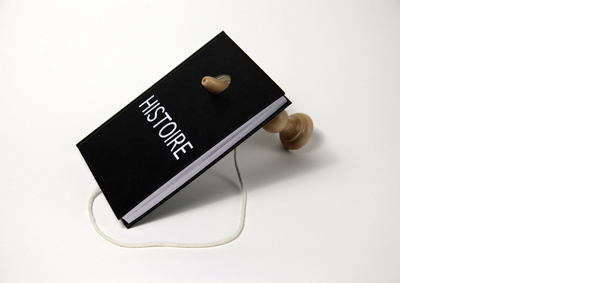
2012, print on baryte paper. 35 x 52 cm, each and 70 x 105 cm each one.
Courtesy of the artist and Ceysson & Bénétière, Paris.
Ed. of 5 + 2 A.P.
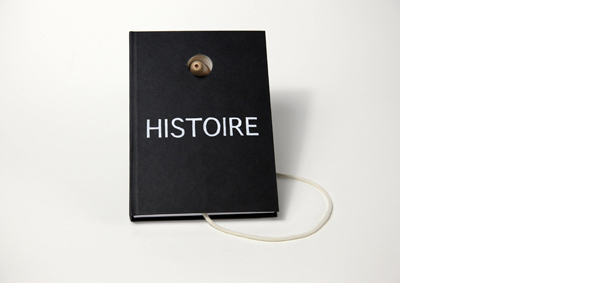
2012, print on baryte paper. 35 x 52 cm, each and 70 x 105 cm each one.
Courtesy of the artist and Ceysson & Bénétière, Paris.
Ed. of 5 + 2 A.P.
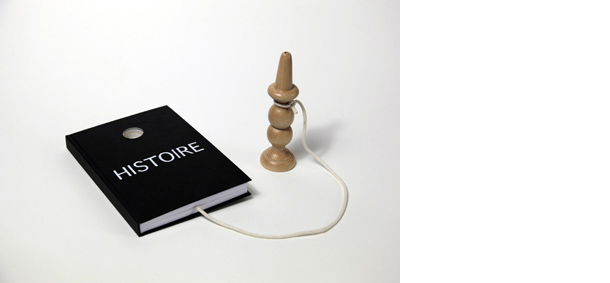
2012, print on baryte paper. 35 x 52 cm, each and 70 x 105 cm each one.
Courtesy of the artist and Ceysson & Bénétière, Paris.
Ed. of 5 + 2 A.P.
'' Without History wants us to consider history as a book, meaning an official publication and a construction where information has been collected and omitted.
Like any written document, history tends to solidify and rigidify events and individuals. ''
Studio Fatmi, July 2017
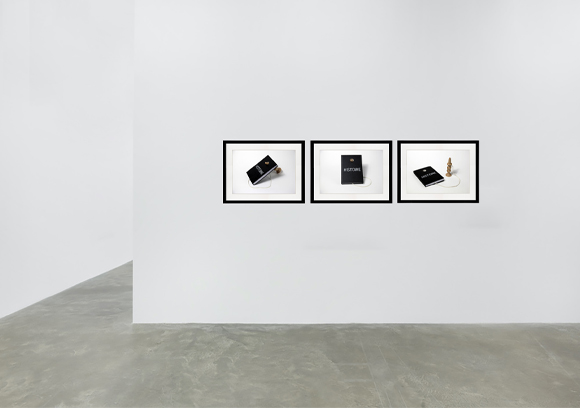
Without History
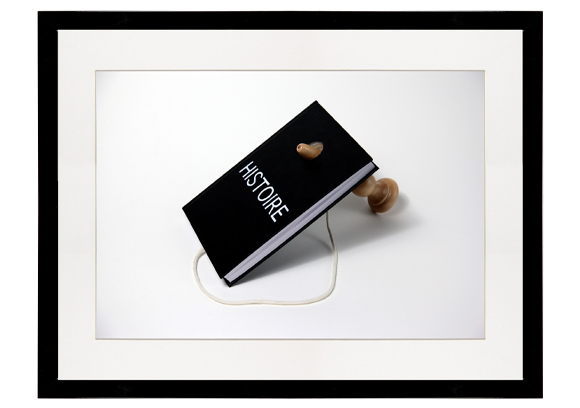
Without History
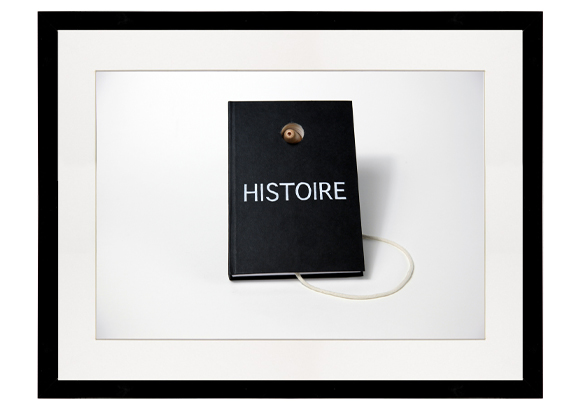
Without History
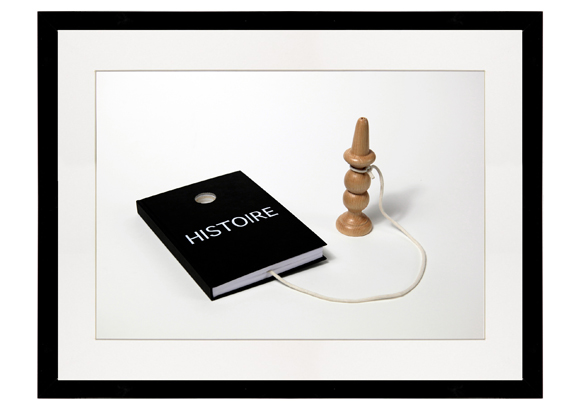
Without History
|
|
|
|
|
|
Sans histoire est un triptyque photographique réalisé à partir d'une sculpture éponyme se composant d'une tige en bois de bilboquet reliée par une cordelette à un livre à couverture noire, percé de part en part, et affichant un titre en lettres capitales blanches : "HISTOIRE". Sur une des photographies, la tige et le livre apparaissent côte à côte, tandis que les deux autres donnent à voir le manche en bois passé dans le trou pratiqué au travers du livre.
L'œuvre photographique interroge l'histoire en tant que relation des événements retraçant l'évolution de l'humanité et explore les liens entre cette mise en récit et l'action humaine collective d'une part et entre histoire et action individuelle d'autre part. Les références historiques sont nombreuses dans le travail de Mounir Fatmi et peuvent s'observer dans des œuvres telles que Sortir de l'histoire, Histoire de l'Histoire ou encore L'Homme sans cheval, qui mettent également en scène le livre à couverture noire intitulé "Histoire". Le livre est un matériau récurrent des œuvres de Mounir Fatmi où ses pouvoirs de mise en circulation des idées mais aussi de censure de l'information sont étudiés.
La serie photographique Sans histoire fonctionne à la manière d'un ready-made à tonalité humoristique qui remet en question les pouvoirs des objets exposés et invite à reconsidérer la manière dont ils sont couramment représentés, à la fois en les confrontant : pouvoir de l'histoire et des grands récits contre pouvoir du jeu et des stratégies à court terme, et également en les associant : l'histoire ou le rapport à celle-ci assimilés à un jeu. L'œuvre autorise les deux points de vue.
Sans histoire invite donc à envisager l'histoire comme un livre, c'est-à-dire comme une publication officielle et un appareil de collecte et d'omission de l'information. Comme tout document écrit, l'histoire a tendance à se figer et à figer les événements décrits et les individus. En tant qu'écriture, ses effets sont comparables à ceux d'un destin ; elle informe et donne forme en exerçant un contrôle sur le cours des existences individuelles. L'œuvre photographique met également en scène l'action humaine s'inscrivant au sein du processus historico-politique comme une stratégie. En tant que telle, sa finalité est la victoire et la domination. Et cependant, si le rapport à l'histoire et l'histoire en tant que telle constituent des formes de jeux, alors leur finalité est au sens stricte improductive : leur gain est nul.
La victoire, l'idée même de but ou de finalité sont des concepts essentiellement humains qui n'existent pas dans la nature. Le titre de l'œuvre est une allusion à la vision historiciste de nombreux courants philosophiques au désir de sens propre à l'humanité. L'histoire en tant que grand récit est une fiction mise à mal par la réalité et les conditions d'existence précaires de l'humanité. Comme dans la vidéo L'Homme sans cheval, Sans histoire évoque la confrontation de l'être humain à une destiné sans finalité. La question se pose alors pour l'individu du rapport à l'histoire et aux pouvoirs en général. Considérée comme un ensemble de déterminismes sociaux et politiques, l'histoire tend à s'opposer aux actions individuelles et à leur éventuelle liberté. Dès lors, toute stratégie individuelle tend à devenir un jeu qui nécessite une certaine adresse. L'enjeu est de trouver un espace vide, une béance dans l'histoire permettant de s'y insérer, d'y inscrire sa propre histoire.
Studio Fatmi, Juillet 2017. |
|
Without History is a photographic triptych created from an eponymous sculpture comprising the wooden stick of a cup-and-ball game attached by a string to a book with a black cover and a hole pierced through it, exhibiting a title in white capital letters: “HISTORY”. In one of the photographs, the stick and the book are next to one another, and in the two others, the stick has been stuck through the hole in the book.
This photographic work questions history as the relation of events retracing the evolution of humanity and explores the relations between that narration and collective human actions on one hand and between history and individual actions on the other. Historical references are numerous in Mounir Fatmi’s work and can be seen in works such as Out of History, History of History and The Man without a Horse, that also feature the book with a black cover entitled “History”. The book is a recurrent material in Mounir Fatmi’s work, which studies its capacity to circulate ideas but also to censor information.
The photographic series Without History works like a ready-made with a humoristic tone, challenging the powers of the exposed objects, and invites us to reconsider the way they are generally represented, by both confronting them (the power of history and great narratives vs. the power of games and short term strategies) and by associating them (history and the relation to history likened to a game). The work allows both points of view.
Without History wants us to consider history as a book, meaning an official publication and a construction where information has been collected and omitted. Like any written document, history tends to solidify and rigidify events and individuals. As a written medium, its effects are comparable to those of someone’s fate: it informs and shapes people by controlling the course of individual lives. The photographic work also shows human actions in the midst of historical and political processes as a strategy. As such, their objective is victory and domination. Nevertheless, if our relation to history and history itself constitute a type of game, then their purpose is strictly speaking unproductive; there is no gain.
Victory and the very idea of objective or purpose are essentially human concepts that don’t exist in nature. The title of the piece is an allusion to the historicist vision of many philosophical currents and to their desire for granting meaning to humanity. History as a great narrative is a fiction upset by reality and the precarious living conditions of humanity. Like in the video The Man without a Horse, Without History evokes the confrontation of human beings with a destiny devoid of purpose. For individuals, this poses the question of their relation to history and the powers that be in general. Considered as a set of social and political determinisms, history tends to oppose itself to individual actions and their potential freedom. This implies that any individual strategy becomes a game requiring a certain degree of dexterity. The objective is to find an empty space, a gaping in history allowing us to slip in and write our own history.
Studio Fatmi, July 2017. |
|
|
|